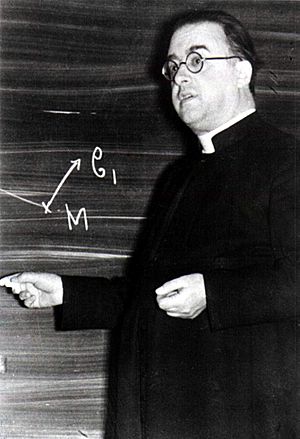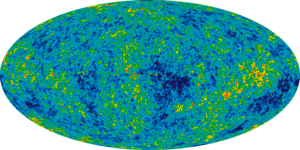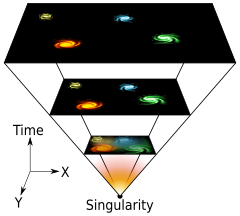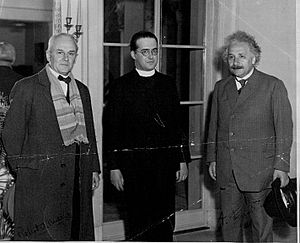Georges Lemaître facts for kids
Quick facts for kids
The Reverend Monsignor
Georges Lemaître
RAS Associate
|
|||||||
|---|---|---|---|---|---|---|---|

Lemaître in 1933
|
|||||||
| Born |
Georges Henri Joseph Édouard Lemaître
17 July 1894 Charleroi, Belgium
|
||||||
| Died | 20 June 1966 (aged 71) Leuven, Belgium
|
||||||
| Nationality | Belgian | ||||||
| Alma mater | Catholic University of Louvain St Edmund's House, Cambridge Massachusetts Institute of Technology |
||||||
| Known for | Theory of the expansion of the universe Big Bang theory Hubble–Lemaître law Lemaître–Tolman metric Lemaître coordinates Friedmann–Lemaître–Robertson–Walker metric |
||||||
| Awards | Francqui Prize (1934) Eddington Medal (1953) |
||||||
| Scientific career | |||||||
| Fields | Cosmology Astrophysics Mathematics |
||||||
| Institutions | Catholic University of Leuven Catholic University of America |
||||||
| Doctoral advisor | Charles Jean de la Vallée-Poussin (Leuven) | ||||||
| Other academic advisors | Arthur Eddington (Cambridge) Harlow Shapley (MIT) |
||||||
|
|||||||
| Signature | |||||||
| Physical cosmology | ||||||||||||||
 |
||||||||||||||
| Universe · Big Bang Age of the universe Timeline of the Big Bang Ultimate fate of the universe
|
||||||||||||||
Georges Henri Joseph Édouard Lemaître (1894–1966) was a Belgian Catholic priest, theoretical physicist, mathematician, and astronomer. He was a professor of physics at the Catholic University of Louvain.
Lemaître was the first to suggest that the universe is expanding. This idea was later confirmed by Edwin Hubble's observations. He also came up with what is now called the Hubble–Lemaître law. He published his findings and an estimate of the Hubble constant in 1927. This was two years before Hubble's famous article.
Lemaître is also known for proposing the "Big Bang theory." He called it the "hypothesis of the primeval atom" or "the beginning of the world." This theory explains how the universe started from a very hot, dense point.
Contents
Early Life and Studies
Georges Lemaître was born in Charleroi, Belgium, on July 17, 1894. He was the oldest of four children. His father was a successful industrial weaver.
He went to a Jesuit high school. At 17, he started studying civil engineering at the Catholic University of Louvain. In 1914, he paused his studies to serve as an artillery officer in the Belgian army during World War I. He received the Belgian War Cross for his service.
After the war, Lemaître studied physics and mathematics. He also began to prepare to become a priest. He earned his doctorate in 1920. He was ordained a priest on September 22, 1923.
In 1923, he became a research assistant in astronomy at the University of Cambridge. He spent a year working with Arthur Eddington, a famous physicist. Eddington taught him about modern cosmology (the study of the universe) and stellar astronomy (the study of stars). The next year, Lemaître studied at Harvard College Observatory and the Massachusetts Institute of Technology (MIT).
Developing the Big Bang Theory
When Lemaître returned to Belgium in 1925, he became a lecturer at the Catholic University of Louvain. In 1927, he published a report that later made him famous. In this report, he presented his new idea that the universe is expanding. He based this idea on Albert Einstein's theory of General Relativity.
Lemaître was the first to estimate the value of the Hubble constant. This constant describes how fast the universe is expanding. His paper was not widely read at first. However, Arthur Eddington helped translate it into English in 1931.
At first, Albert Einstein did not believe the universe was expanding. He told Lemaître, "Your calculations are correct, but your physics is terrible." However, Einstein later changed his mind.
In 1931, Lemaître proposed that the universe began from a single point. He called this point the "Primeval Atom." He published this idea in the science journal Nature. This theory later became known as the "Big Bang theory." The term "Big Bang" was playfully made up by astronomer Fred Hoyle in 1949. Hoyle actually supported a different idea called the steady state universe.
Lemaître's idea was met with some doubt from other scientists at first. Even Einstein found it hard to accept. However, Lemaître argued that Einstein's own model of a static (non-changing) universe could not last forever.
Later Career and Discoveries

Lemaître also worked with Manuel Sandoval Vallarta on cosmic rays. They found that the strength of cosmic rays changes depending on how close they are to Earth's magnetic field. They used an early computer called a differential analyzer for their calculations.
Lemaître and Einstein met several times. In 1933, after Lemaître explained his theory in California, Einstein reportedly said, "This is the most beautiful and satisfactory explanation of creation to which I have ever listened."
In 1933, Lemaître's theory of the expanding universe gained wide public attention. Newspapers around the world called him a famous Belgian scientist.
Lemaître became a member of the Pontifical Academy of Sciences in 1936. He was its president from 1960 until his death. In 1946, he published a book called The Primeval Atom Hypothesis.
Lemaître believed that his scientific theories did not conflict with his religious faith. He thought that science and religion were separate but not opposed.
Towards the end of his life, Lemaître became very interested in computers. He brought the first electronic computer to his university in 1958. He was also interested in computer programming.
Georges Lemaître died on June 20, 1966. This was shortly after scientists discovered cosmic microwave background radiation. This discovery provided strong evidence for his Big Bang theory.
Key Contributions
Lemaître was a pioneer in using Albert Einstein's theory of general relativity to study the universe.
- In 1927, he published an article that described the expansion of the universe. This was two years before Edwin Hubble's famous paper.
- He was the first to estimate the numerical value of the Hubble constant.
- He proposed that the expansion of the universe explains why light from distant galaxies appears redder (called redshift).
- He suggested that the universe started from a single, very dense point, which he called the "primeval atom." This is now known as the Big Bang theory.
- He was the first to suggest that the expansion of the universe was actually speeding up. This was confirmed by observations in the 1990s.
- Lemaître was also one of the inventors of the Fast Fourier transform algorithm, which is used in many calculations today.
Honours and Recognition
Lemaître received many awards for his scientific work:
- In 1934, he received the Francqui Prize, the highest Belgian scientific award. Albert Einstein was one of the people who nominated him.
- In 1936, he received the Prix Jules Janssen, a top award from the French astronomical society.
- In 1953, he was given the first Eddington Medal by the Royal Astronomical Society.
In 2018, the International Astronomical Union voted to change the name of the Hubble law to the Hubble–Lemaître law. This was done to recognize Lemaître's important early work on the expanding universe.
On July 17, 2018, Google Doodle celebrated Georges Lemaître's 124th birthday.
Images for kids
See also
 In Spanish: Georges Lemaître para niños
In Spanish: Georges Lemaître para niños
- Cold Big Bang
- List of Roman Catholic cleric-scientists
- List of Christians in science and technology
- Michał Heller – Polish Catholic priest and physicist/astronomer.


